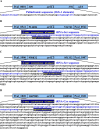Recent Advances in the Identification of Replication Origins Based on the Z-curve Method
- PMID: 24822028
- PMCID: PMC4009838
- DOI: 10.2174/1389202915999140328162938
Recent Advances in the Identification of Replication Origins Based on the Z-curve Method
Abstract
Precise DNA replication is critical for the maintenance of genetic integrity in all organisms. In all three domains of life, DNA replication starts at a specialized locus, termed as the replication origin, oriC or ORI, and its identification is vital to understanding the complex replication process. In bacteria and eukaryotes, replication initiates from single and multiple origins, respectively, while archaea can adopt either of the two modes. The Z-curve method has been successfully used to identify replication origins in genomes of various species, including multiple oriCs in some archaea. Based on the Z-curve method and comparative genomics analysis, we have developed a web-based system, Ori-Finder, for finding oriCs in bacterial genomes with high accuracy. Predicted oriC regions in bacterial genomes are organized into an online database, DoriC. Recently, archaeal oriC regions identified by both in vivo and in silico methods have also been included in the database. Here, we summarize the recent advances of in silico prediction of oriCs in bacterial and archaeal genomes using the Z-curve based method.
Keywords: Archaea; Bacteria; Comparative genomics; Origins of replication; Z-curve..
Figures




References
-
- Jacob F, Brenner S, Cuzin F. On the regulation of DNA replication in bacteria. Cold Spring Harbor Symposia on Quant. Biol. 1963;28:329–348.
-
- Katayama T, Ozaki S, Keyamura K, Fujimitsu K. Regulation of the replication cycle: conserved and diverse regulatory systems for DnaA and oriC. Nat. Rev. Microbiol. 2010;8(3):163–170. - PubMed
-
- Mott ML, Berger JM. DNA replication initiation: mechanisms and regulation in bacteria. Nat. Rev. Microbiol. 2007;5(5):343–354. - PubMed
-
- Zhou Y, Chen WL, Wang L, Zhang CC. Identification of the oriC region and its influence on heterocyst development in the filamentous cyanobacterium Anabaena sp.strain PCC 7120. Microbiol. 2011;157(Pt 7):1910–1919. - PubMed
-
- Xu Y, Ji X, Chen N, Li P, Liu W, Lu X. Development of replicative oriC plasmids and their versatile use in genetic manipulation of Cytophaga hutchinsonii. Appl. Microbiol. Biotech. 2012;93(2):697–705. - PubMed
LinkOut - more resources
Full Text Sources
Other Literature Sources
Molecular Biology Databases
